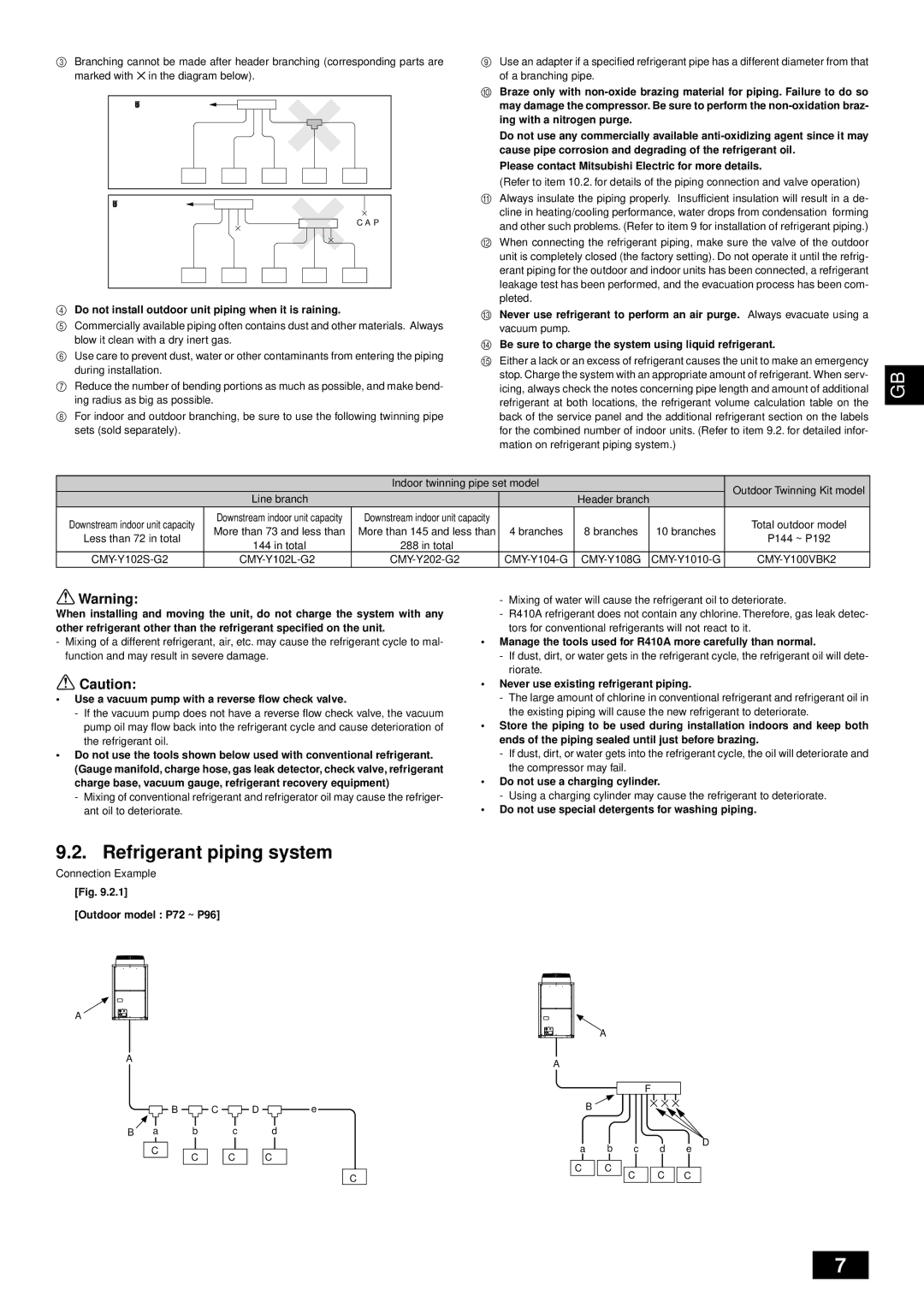
3Branching cannot be made after header branching (corresponding parts are marked with ![]() in the diagram below).
in the diagram below).
To the outdoor unit ![]()
![]()
![]()
To the outdoor unit ![]()
![]()
![]()
CAP
4Do not install outdoor unit piping when it is raining.
5Commercially available piping often contains dust and other materials. Always blow it clean with a dry inert gas.
6Use care to prevent dust, water or other contaminants from entering the piping during installation.
7Reduce the number of bending portions as much as possible, and make bend- ing radius as big as possible.
8For indoor and outdoor branching, be sure to use the following twinning pipe sets (sold separately).
9Use an adapter if a specified refrigerant pipe has a different diameter from that of a branching pipe.
0Braze only with
Do not use any commercially available
Please contact Mitsubishi Electric for more details.
(Refer to item 10.2. for details of the piping connection and valve operation)
AAlways insulate the piping properly. Insufficient insulation will result in a de- cline in heating/cooling performance, water drops from condensation forming and other such problems. (Refer to item 9 for installation of refrigerant piping.)
BWhen connecting the refrigerant piping, make sure the valve of the outdoor unit is completely closed (the factory setting). Do not operate it until the refrig- erant piping for the outdoor and indoor units has been connected, a refrigerant leakage test has been performed, and the evacuation process has been com- pleted.
CNever use refrigerant to perform an air purge. Always evacuate using a vacuum pump.
DBe sure to charge the system using liquid refrigerant.
EEither a lack or an excess of refrigerant causes the unit to make an emergency stop. Charge the system with an appropriate amount of refrigerant. When serv- icing, always check the notes concerning pipe length and amount of additional refrigerant at both locations, the refrigerant volume calculation table on the back of the service panel and the additional refrigerant section on the labels for the combined number of indoor units. (Refer to item 9.2. for detailed infor- mation on refrigerant piping system.)
GB
|
| Indoor twinning pipe set model |
|
| Outdoor Twinning Kit model | ||
| Line branch |
|
| Header branch |
|
| |
Downstream indoor unit capacity | Downstream indoor unit capacity | Downstream indoor unit capacity |
|
|
| Total outdoor model | |
More than 73 and less than | More than 145 and less than | 4 branches | 8 branches | 10 branches | |||
Less than 72 in total | P144 ~ P192 | ||||||
144 in total | 288 in total |
|
|
| |||
|
|
|
|
| |||
![]() Warning:
Warning:
When installing and moving the unit, do not charge the system with any other refrigerant other than the refrigerant specified on the unit.
- Mixing of a different refrigerant, air, etc. may cause the refrigerant cycle to mal- function and may result in severe damage.
![]() Caution:
Caution:
•Use a vacuum pump with a reverse flow check valve.
-If the vacuum pump does not have a reverse flow check valve, the vacuum pump oil may flow back into the refrigerant cycle and cause deterioration of the refrigerant oil.
•Do not use the tools shown below used with conventional refrigerant. (Gauge manifold, charge hose, gas leak detector, check valve, refrigerant charge base, vacuum gauge, refrigerant recovery equipment)
-Mixing of conventional refrigerant and refrigerator oil may cause the refriger- ant oil to deteriorate.
-Mixing of water will cause the refrigerant oil to deteriorate.
-R410A refrigerant does not contain any chlorine. Therefore, gas leak detec- tors for conventional refrigerants will not react to it.
•Manage the tools used for R410A more carefully than normal.
-If dust, dirt, or water gets in the refrigerant cycle, the refrigerant oil will dete- riorate.
•Never use existing refrigerant piping.
-The large amount of chlorine in conventional refrigerant and refrigerant oil in the existing piping will cause the new refrigerant to deteriorate.
•Store the piping to be used during installation indoors and keep both ends of the piping sealed until just before brazing.
-If dust, dirt, or water gets into the refrigerant cycle, the oil will deteriorate and the compressor may fail.
•Do not use a charging cylinder.
-Using a charging cylinder may cause the refrigerant to deteriorate.
•Do not use special detergents for washing piping.
9.2. Refrigerant piping system
Connection Example
[Fig. 9.2.1]
[Outdoor model : P72 ~ P96]
A![]()
A
B ![]() C
C
B | a |
| b |
C
C
c
C
D![]()
d
C
e
| A |
A |
|
| F |
B |
|
a | b c d e D |
C | C |
C
C C C |
7
